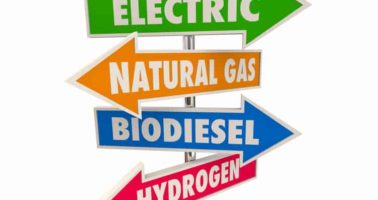Directive 2014/94 / EU of the European Parliament and of the Council of October 22, 2014 on the implementation of an infrastructure for alternative fuels
The directive affects all modes of transport: land, sea, river, rail and air. Part of the Commission Communication of March 3, 2010 entitled «Europe 2020: A strategy for smart, sustainable and inclusive growth', The objective was then set to strengthen competitiveness and energy security through a more efficient use of resources and energy.
Later in the White Book of the Commission of March 28, 2011, entitled «Roadmap towards a single European transport area: towards a competitive and sustainable transport policy»Called for a reduction in the dependence of transport on oil. Such an objective must be achieved through a series of policy initiatives, in particular through the development of a sustainable alternative fuels strategy and the development of appropriate infrastructure. The Commission's White Paper also proposed a reduction, between now and 2050, in emissions of greenhouse gases from transport 60 % compared to 1990 levels.
On the other hand, Directive 2009/28 / EC of the European Parliament and of the Council sets the target of a market share of 10 % for renewable energy in transport.
Based on the consultation of interested parties and national experts, as well as the experience gained reflected in the Commission Communication of 24 January 2013, entitled 'Clean energy for transport: European strategy on alternative fuels», Electricity, hydrogen, biofuels, natural gas and liquefied petroleum gas (LPG), as well as their possible simultaneous and combined use, for example through mixed technology systems, are currently considered the main alternative fuels with the potential to replace oil in the long term.
The guidelines of the Trans-European Transport Network (TEN-T) recognize that alternative fuels serve, at least partially, as a substitute for fossil fuels in the supply of energy for transport, contribute to its decarbonisation and improve environmental performance. of the transport sector. The TEN-T guidelines require, with regard to new technologies and innovation, that the TEN-T promote the decarbonisation of all modes of transport both by stimulating energy efficiency and by introducing propulsion systems alternatives and the creation of the corresponding infrastructure. The TEN-T guidelines also require that the inland and sea ports and the airports and roads of the basic network established by Regulation (EU) No 1315/2013 of the European Parliament and of the Council provide for the availability of clean alternative fuels.
The lack of harmonized development of alternative fuels infrastructure across the Union prevents economies of scale in supply and Union-wide mobility in demand.
It is necessary to create new infrastructure networks, for example for electricity, natural gas [liquefied natural gas (LNG) and compressed natural gas (CNG)], and, where appropriate, hydrogen.
Directive 2014/94 / EU
It is important recognize the different stages of development of each technology and its corresponding infrastructure, including the maturity of business models for private investors and the availability of alternative fuels and their acceptance by users. It would be necessary to guarantee technological neutrality and ensure that national action frameworks take due account of the requirement to support commercial development of alternative fuels.
LNG is an interesting alternative fuel that allows ships to meet the requirements of limitation of sulfur content of marine fuels in SOx emission control areas, which concerns half of the ships that carry out short sea shipping in Europe, in accordance with the provisions of Directive 2012/33 / EU of the European Parliament and the Council.
A basic network of LNG refueling points in sea and river ports should be available no later than 2025 and 2030, respectively. LNG refueling points include LNG terminals, tanks, mobile containers, tankers, and barges.
This initial attention to the basic network should not exclude the possibility of having LNG, in the longer term, in ports not included in the basic network, particularly in ports that are important for non-transport vessels. The decision on the location of LNG refueling points L 307/6 EN Official Journal of the European Union 28.10.2014 Directive 2012/33 / EU of the European Parliament and of the Council, of November 21, 2012, by which amends Council Directive 1999/32 / EC as regards the sulfur content of fuels for marine use (OJ L 327, 27.11.2012, p. 1). in ports should be based on a cost-benefit analysis including an examination of environmental benefits. The applicable safety regulations must also be taken into account. The implementation of an infrastructure for LNG contemplated in this Directive should not stop the development of other energy efficient alternative fuels that may appear.
In 2020/21 a rreview of this Directive aligned with the European Green Deal.

